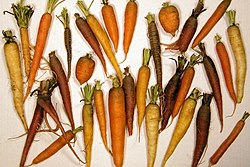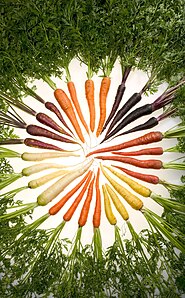Carrot
It has been suggested that this article be merged into Wild carrot. (Discuss) Proposed since April 2007. |
| Carrot | |
|---|---|

| |
| Harvested carrots | |
| Scientific classification | |
| Kingdom: | |
| Division: | |
| Class: | |
| Order: | |
| Family: | |
| Genus: | |
| Species: | D. carota
|
| Binomial name | |
| Daucus carota | |
| Nutritional value per 100 g (3.5 oz) | |||||||||||||||||||||||||||||||||||
|---|---|---|---|---|---|---|---|---|---|---|---|---|---|---|---|---|---|---|---|---|---|---|---|---|---|---|---|---|---|---|---|---|---|---|---|
| Energy | 173 kJ (41 kcal) | ||||||||||||||||||||||||||||||||||
9 g | |||||||||||||||||||||||||||||||||||
| Sugars | 5 g | ||||||||||||||||||||||||||||||||||
| Dietary fiber | 3 g | ||||||||||||||||||||||||||||||||||
0.2 g | |||||||||||||||||||||||||||||||||||
1 g | |||||||||||||||||||||||||||||||||||
| |||||||||||||||||||||||||||||||||||
| †Percentages estimated using US recommendations for adults,[1] except for potassium, which is estimated based on expert recommendation from the National Academies.[2] | |||||||||||||||||||||||||||||||||||
A Carrot, Devil's Plague or Bird's Nest Plant (Daucus carota) is a root vegetable, usually orange or white in color with a woody texture. The edible part of a carrot is a taproot. It is a biennial plant which grows a rosette of leaves in the spring and summer while building up the stout taproot, which stores large amounts of sugars for the plant to flower in the second year. The flowering stem grows to about 1 m tall, with umbels of white flowers.
Uses
Carrots can be eaten raw, whole, chopped, grated into salads for color or texture, and are also often chopped and boiled, fried or steamed, and cooked in soups and stews. A well known dish is Carrots Julienne. Grated carrots are used in carrot cakes and carrot puddings. The greens are edible as a leaf vegetable, but are rarely eaten. Together with onion and celery, carrots are one of the primary vegetables used in a mirepoix to make various broths.

Since the late 1980s, baby carrots or mini carrots, carrots that have been peeled and cut into uniform cylinders, have been a popular ready-to-eat snack food in many supermarkets.
β-carotene, a dimer of Vitamin A, is abundant in the carrot and gives this vegetable its characteristic orange color. Furthermore, carrots are rich in dietary fiber, antioxidants, and minerals.
Carrot juice is also widely marketed.
Ethnomedically, the roots are used to treat digestive problems, intestinal parasites, and tonsilitis.
History
The wild ancestors of the carrot are likely to have come from Afghanistan, which remains the center of diversity of D. carota. The familiar wild plant wild carrot, sometimes called Queen Anne's lace, is the same species as the garden carrot (which was bred from it); garden carrots that run to seed soon revert to their wild prototype, with a forking carroty-smelling, edible root that quickly becomes too woody and bitter to eat.
In early use, carrots were grown for their aromatic leaves and seeds, not their roots. The first mention of the root in classical sources is in the 1st century CE. The modern carrot appears to have been introduced to Europe in the 8-10th centuries; Ibn al-Awam, in Andalusia, describes both 'red' and 'yellow' carrots; Simeon Seth also mentions both colors in the 11th century. Orange-colored carrots appear in the Netherlands in the 17th century.[3]
The parsnip is a close relative of the carrot.
Cultivars

Carrot cultivars can be grouped into two broad classes: eastern carrots and western carrots. More recently, a number of novelty cultivars have been bred for particular characteristics.
Eastern carrots
Eastern carrots were domesticated in Central Asia, probably in modern-day Afghanistan in the 10th century or possibly earlier. Those of the eastern carrot that survive to the present day are commonly purple or yellow in color, and often have branched roots. The purple color common in these carrots comes from anthocyanin pigments.
Western carrots

The Western carrot emerged in the Netherlands in the 15th or 16th century, its orange color making it popular in those countries as an emblem of the House of Orange and the struggle for Dutch independence. The orange color results from abundant carotenes in these cultivars. While orange carrots are nearly ubiquitous in the West, other colors do exist, including white, yellow, red, and purple. These other colors of carrot are raised primarily as novelty crops.
The Vegetable Improvement Center at Texas A&M University has developed a purple-skinned, orange-fleshed carrot, the BetaSweet (also known as the Maroon Carrot), with substances to prevent cancer, which has recently entered commercial distribution.
Western carrot cultivars are commonly classified by their root shape:
- 'Imperator' carrots are the carrots most commonly sold whole in U.S. supermarkets; their roots are longer than other cultivars of carrot, and taper to a point at the tip.
- 'Nantes' carrots are nearly cylindrical in shape, and are blunt and rounded at both the top and tip. Nantes cultivars are often sweeter than other carrots.
- 'Danvers' carrots have a conical shape, having well-defined shoulders and tapering to a point at the tip. They are somewhat shorter than Imperator cultivars, but more tolerant of heavy soil. Danvers cultivars are often pureed as baby food.
- 'Chantenay' carrots are shorter than other cultivars, but have greater girth, sometimes growing up to 8 cm (3 inches) in diameter. Shapewise, they have broad shoulders and taper towards a blunt, rounded tip. They are most commonly diced for use in canned or prepared foods.
While any carrot can be harvested before reaching its full size as a more tender "baby" carrot, some fast-maturing cultivars have been bred to produce smaller roots. The most extreme examples produce round roots about 2.5 cm (1 inch) in diameter. These small cultivars are also more tolerant of heavy or stony soil than long-rooted cultivars such as 'Nantes' or 'Imperator'. The "baby carrots" sold ready-to-eat in supermarkets, are however often not from a smaller cultivar of carrot, but are simply full-sized carrots that have been sliced and peeled to make carrot sticks of a uniform shape and size.
Carrot flowers are pollinated primarily by bees. Seed growers use honeybees or mason bees for their pollination needs.
Carrots are used as food plants by the larvae of some Lepidoptera species including Common Swift, Garden Dart, Ghost Moth, Large Yellow Underwing and Setaceous Hebrew Character.
Novelty carrots

Food enthusiasts and researchers have obtained other varieties of carrots through traditional breeding methods. One particular species lacks the usual orange pigment from carotenes, owing its white color to a recessive gene for tocopherol (Vitamin E). Derived from Daucus carota L. and patented (US patent #6,437,222) at the University of Wisconsin-Madison, the variety is intended to supplement dietary intake of Vitamin E.
Trivia
- In 2005, a poll of 2,000 people revealed that the carrot was Britain's third favourite culinary vegetable.[4]
- Carrots are noted in popular culture for being the favorite food of rabbits, and are also associated with fictional rabbits such as Bugs Bunny. However, rabbits finding carrots in a garden are more likely to eat the exposed greens than to dig up the root.
- For the purposes of the European Union's "Council Directive 2001/113/EC of 20 December 2001 relating to fruit jams, jellies and marmalades and sweetened chestnut purée intended for human consumption" carrots can be defined as a fruit as well as a vegetable. This is because carrot jam is a Portuguese delicacy.
- A common urban legend is that carrots aid a human being's night vision. It is believed that disinformation introduced in 1940 by John "Cat's Eyes" Cunningham during the Battle of Britain was an attempt to cover up the discovery and use of radar technologies [5][6]. It reinforced existing German folklore and helped to encourage children to eat the vegetable. Lack of Vitamin A can, however, cause poor vision and can be restored by adding Vitamin A back into the diet.
- The world's largest carrot was grown in Palmer, Alaska, by John Evans in 1998, weighing 8.614 kg (18.99 pounds).
- The world's largest carrot statue is located in Ohakune, New Zealand.[7]
- Carrots are traditionally used as noses when building snowmen.
- The comedian and entertainer "Carrot Top" is named after a carrot because of his bright orange hair.
- Susan Dey, of Partridge Family fame, was said to have eaten so many carrots during her bout with anorexia and bulimia that her skin literally was tinged with orange - a condition called carotenosis. [8]
- Holtville, California holds an annual festival devoted entirely to the carrot.
See also
- List of carrot diseases
- Arracacha
- Parsnip
- Skirret
- Falcarinol
- Carrot fly
- Gezer (Hebrew for carrot)
References
- ^ United States Food and Drug Administration (2024). "Daily Value on the Nutrition and Supplement Facts Labels". FDA. Archived from the original on 2024-03-27. Retrieved 2024-03-28.
- ^ National Academies of Sciences, Engineering, and Medicine; Health and Medicine Division; Food and Nutrition Board; Committee to Review the Dietary Reference Intakes for Sodium and Potassium (2019). Oria, Maria; Harrison, Meghan; Stallings, Virginia A. (eds.). Dietary Reference Intakes for Sodium and Potassium. The National Academies Collection: Reports funded by National Institutes of Health. Washington, DC: National Academies Press (US). ISBN 978-0-309-48834-1. PMID 30844154. Archived from the original on 2024-05-09. Retrieved 2024-06-21.
- ^ Oxford Companion to Food; Andrew Dalby, Siren Feasts: A History of Food and Gastronomy in Greece, Routledge, 1996. ISBN 0-415-11620-1, p. 182; Andrew Dalby, Food in the Ancient World from A-Z, 2003, ISBN 0-415-23259-7, p. 75
- ^ Martin Wainwright. "Onions come top for British palates". Guardian Unlimited. Guardian Newspapers Limited.
- ^ Mikkelson, Barbara & David P. "Carrots" at Snopes.com: Urban Legends Reference Pages.
- ^ Karl S. Kruszelnicki. "Carrots & Night Vision". Great Moments in Science. ABC.
- ^ staff. "Ohakune - Carrot Capital". Ruapehu Bulletin. Ruapehu Bulletin.
- ^ unknown. "Susan Dey". unknown. All American Speakers.
External links
- "Carrots". The World's Healthiest Foods.
- Daucus carota sativus - Plants For a Future database entry
- Carrot and Garlic Genetics - diverse information on carrots, with links to more (USDA)
- Carrots - selecting cultivars best suited for home gardening, with growing information
- "BetaSweet purple carrot". Texas A&M.
- Carrot Cooking and purchasing tips
- Template:Dmoz
- World Carrot Museum
- "Processing Carrot Research Program". Nova Scotia Agricultural College.
- "Carrots - Nutrional Information". About.com.
